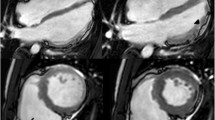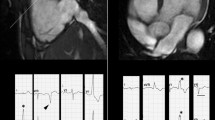Abstract
Arrhythmogenic right ventricular dysplasia (ARVD) is a heart muscle disorder of unknown cause that is characterized pathologically by fibrofatty replacement of the right ventricular myocardium. Clinical manifestations include structural and functional malformations of the right ventricle, electrocardiographic abnormalities, and presentation with ventricular tachycardias with left bundle branch pattern or sudden death. The disease is often familial with an autosomal inheritance. In addition to right ventricular dilatation, right ventricular aneurysms are typical deformities of ARVD and they are distributed in the so-called “triangle of dysplasia”, i. e., right ventricular outflow tract, apex, and infundibulum. Ventricular aneurysms at these sites can be considered pathognomonic of ARVD. Another typical hallmark of ARVD is fibrofatty infiltration of the right ventricular free wall. These functional and morphologic characteristics are relevant to clinical imaging investigations such as contrast angiography, echocardiography, radionuclide angiography, ultrafast computed tomography, and magnetic resonance imaging (MRI). Among these techniques, MRI allows the clearest visualization of the heart, in particular because the right ventricle is involved, which is usually more difficult to explore with the other imaging modalities. Furthermore, MRI offers the specific advantage of visualizing adipose infiltration as a bright signal of the right ventricular myocardium. MRI provides the most important anatomic, functional, and morphologic criteria for diagnosis of ARVD within one single study. As a result, MRI appears to be the optimal imaging technique for detecting and following patients with clinical suspicion of ARVD.
Zusammenfassung
Die arrhythogene rechtsventrikuläre Dysplasie (ARVD), eine Herzmuskelerkrankung unlarer Ätiologie, ist pathologisch durch fettige Degeneration des rechtsventrikulären Myokards gekennzeichnet. Die klinischen Symptome umfassen strukturelle und funktionelle Malformationen des rechten Ventrikels, krankhafte elektrokardiographische Befunde und das Auftreten ventrikulärer Tachykardien mit Linksschenkelblock oder plötzlichem Herztod. Die Krankheit tritt familiär gehäft auf und wird autosomal vererbt. Neben der rechtsventrikulären Dilatation stellen rechtsventrikuläre Aneurysmen typische Fehlbildungen bei ARVD dar. Sie sind im so genannten “Dysplasiedreieck”, das heißt rechtem ventrikulärem Ausflusstrakt, Herzspitze und Infundibulum, verteilt. Dort lokalisierte ventrikuläre Aneurysmen können als pathognomonisch für die ARVD angesehen werden. Ein weiteres typisches Merkmal der ARVD ist die fettige Degeneration der freien rechten Ventrikelwand. Diese funktionellen und strukturellen Charakteristika sind bei der klinischen Untersuchung mit bildgebenden Verfahren wie Kontrastangiographie, Echokardiographie, Radionuklidangiographie, ultraschneller Computertomographie und Magnetresonanztomographie (MRT) von Bedeutung. Unter diesen Verfahren erlaubt die MRT die deutlichste Darstellung des Herzens, insbesondere bei Beteiligung des rechten Ventrikels, der sich mit den anderen bildgebenden Methoden in der Regel schwerer untersuchen lässt. Darüber hinaus bietet die MRT den wesentlichen Vorteil der Darstellung der fettigen Degeneration als helles Signal im rechtsventrikulären Myokard. Die MRT liefert die wichtigsten anatomischen, funktionellen und morphologischen Kriterien zur Diagnose einer ARVD in einem einzigen Untersuchungsgang. Daher scheint sie das beste bildgebende Verfahren zur Identifizierung und Nachsorge von Patienten mit klinischem Verdacht auf ARVD zu sein.
Similar content being viewed by others
Author information
Authors and Affiliations
Additional information
Rights and permissions
About this article
Cite this article
van der Wall, E., Kayser, H., Bootsma, M. et al. Arrhythmogenic Right Ventricular Dysplasia: MRI Findings. Herz 25, 356–364 (2000). https://doi.org/10.1007/s000590050028
Issue Date:
DOI: https://doi.org/10.1007/s000590050028




